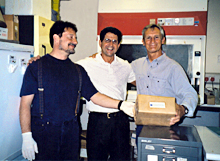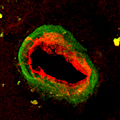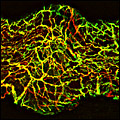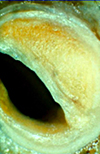Andrzej Loesch
PhD, DSc, FRSB
Professor of Medical Sciences
Visitor to Division of Medicine
Royal Free Campus
University College London
Rowland Hill Street
London NW3 2PF, UK
Email: a.loesch@ucl.ac.uk
aloesch@talktalk.net
Research Interests
I am a cell biologist working in the field of vascular structure, including the structural relationship between the autonomic nervous system and the vascular system. My research is focused on issues relevant to clinical medicine, and is carried out in collaboration with distinguished clinical institutes and units in the UK and overseas. The major aim of my studies is to identify the fine cellular localisation of substances and their receptors that are crucial to the physiological properties of blood vessels. This is in the context of the mechanisms underlying diseased human blood vessels, particularly cerebral and coronary arteries.
Recent Research Projects
Evaluation of tissue structure in amyloidosis
New directions: Evaluation of amyloid deposits in relation to the tissues/organ
structure and to the response to treatment.
Centre for Amyloidosis and Acute Phase Proteins (Prof. Sir Mark B Pepys, Director, Wolfson Drug Discovery Unit, University College London).
Saphenous vein harvesting technique for coronary bypass surgery
(L to R) Andrzej Loesch, Domingos Souza
and M Dashwood, collaborating.

A new grafting technique ('no-touch') for the treatment of diseased coronary arteries has been developed and successfully applied by Dr DSR Souza, Consultant Cardiothoracic Surgeon at Örebro University Hospital in Sweden (Souza 1996 Scand J Thor Cardiovasc Surg 30:11-4;Souza et al. 2002 Ann Thorac Surg 73:1189-95). This method minimizes mechanical trauma, and is therefore potentially crucial to graft survival and hence patient health. Our research aims to understand the mechanisms underlying the success of this technique. The project creates close links between the clinical treatment of coronary artery disease and biological cardiovascular research. See Gallery 1 for an image of saphenous vein harvested by 'no touch' technique.
Collaboration with Dr. Domingos SR Souza: Department of Cardiothoracic Surgery, Örebro University Hospital, Örebro, Sweden. Email: domingos.souza@orebroll.se
Dr. MR Dashwood: Department of Molecular Pathology and Clinical Biochemistry, Royal Free and University College Medical School, London. Email: mdashwood@rfc.ucl.ac.uk
Human cerebral vessels in neurodegenerative disorders
Localisation of various vasoactive substances in human main cerebral vessels, mainly in endothelial cells, perivascular nerves and vascular smooth muscle cells.
Collaboration with Dr. A. Kingsbury and Ms. L. Kilford, Queens Square Brain Bank for Neurological Disorders, Institute of Neurology, University College London.
Vascular structure and NOS
Focus on immunocytochemistry and vascular structure alterations upon prolonged lack of NOS3
Collaboration with Dr. Sidney G. Shaw, Head, Vasoactive Peptide Group, Department of Clinical Research, University of Bern, Bern, Switzerland. Email: shaw@dkf5.unibe.ch
Anatomy and stereology of autonomic and vascular systems
The aim of this study is to reveal the structural and immunohistochemical changes in autonomic ganglia in health and disease; a relationship to vasculature.
Collaboration with Dr. Antonio A Coppi, Department of Surgery, College of Veterinary Medicine, University of São Paulo (USP), São Paulo, Brazil.
Other research collaborations include
1. Prof. G. Burnstock, Director, Autonomic
Neuroscience Institute, Royal Free and University College Medical School, London, UK.
Various aspects of P2 (purine) receptors localisation.
See Gallery 2 for an image of HUVECs and P2X6 receptor localisation.
3. Prof. R. Unwin,
Director, Centre for Nephrology, Royal Free and University College Medical
School, Middlesex Hospital, London W1T 3AA, UK.
(i) Receptors for purines and renal function
(ii) Insulin entrance to the kidney tissue







